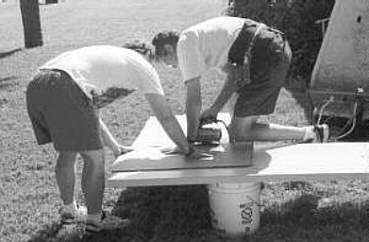| By Michael Wacht KISSIMMEE — It’s been seven
months since a deadly string of tornadoes hit Central Florida, leaving twisted homes and
broken lives in their path. But relief efforts begun by the United Methodist Committee on
Relief (UMCOR) in Osceola County are still going strong and making a real difference in
people’s lives.
“Over and over, they’re [victims] saying: ‘Thank you for being still being
here. We’re just now getting into our home,’ ” said Lisa Higley, operations
manager for the Osceola Interfaith Emergency Coalition Inc.
The Coalition is a non-profit disaster relief organization of more than 11 area churches
and organizations that grew out of UMCOR’s efforts at First United Methodist Church,
St. Cloud, after the tornadoes hit. It was incorporated in March with several United
Methodist pastors and lay members serving as officers and board members, and is funded in
part by UMCOR and the Orlando District Emergency Response Committee. Its goal is to
satisfy the unmet needs of disaster victims in Osceola County.
“The insurance money is just now paying off,” Higley said. “People have the
money to fix the major needs, but they can’t afford to fix everything. That’s
where we come in. We’re coordinating the work that needs to be done with the agencies
that have the expertise in place.”
Amparo Estrada’s family is one of the 211 families the Coalition has helped. A single
mother with a 14-year-old son, Estrada moved to Florida from Colombia, South America, and
lives on a fixed income. During the tornadoes, she lost her roof and several windows, and
rain and power surges damaged most of her home’s interior. Because she didn’t
have insurance, she received a grant from the Federal Emergency Management Agency (FEMA),
which covered many of the repairs, but not all of them.
When a volunteer from the Coalition called her in June, she told him the storms had ruined
her air conditioning unit and damaged her kitchen cabinets. By August, the Coalition had
paid to replace the air conditioner. A United Methodist Volunteers in Mission team from
Virginia installed the new cabinets in October.
“God is with me and truly helped me with what I needed,” Estrada said.
“Thank you to God and to the church for all that you’ve done for me.”
Although groups like the American Red Cross, Salvation Army and FEMA are still providing
help, many people don’t know how to access that aid. The staff and volunteers at the
Coalition assist and represent victims in the process of applying for help.
When those avenues of assistance are exhausted, a family’s situation is presented to
the Coalition’s board. Based on Higley’s recommendation, the board decides how
to help.
Higley said many of the victims were on fixed incomes before the disaster and have budgets
that can’t absorb costs for temporary housing and insurance deductibles. Many were
left with no money for food or clothes.
“We furnished $100 each for 135 children to go to Wal-Mart and buy school
clothes,” she said.
Higley says 20 families still rely on the Coalition for food and water each month, and
there are more than 65 requests for help that haven’t been met, including repairing
21 houses.
But there are also emotional needs. “When it clouds up, they’re still terrified,
and some go to relatives’ homes. We have prayed with and encouraged
victims…” Higley says. “There’s still a lot of fear.” |
![]()
![]()
![]()
![]()
![]()
![]()
![]() Florida Southern College
Florida Southern College![]()
![]() Bethune Cookman College
Bethune Cookman College![]()
![]() FL
UM Childrens Home
FL
UM Childrens Home![]()

